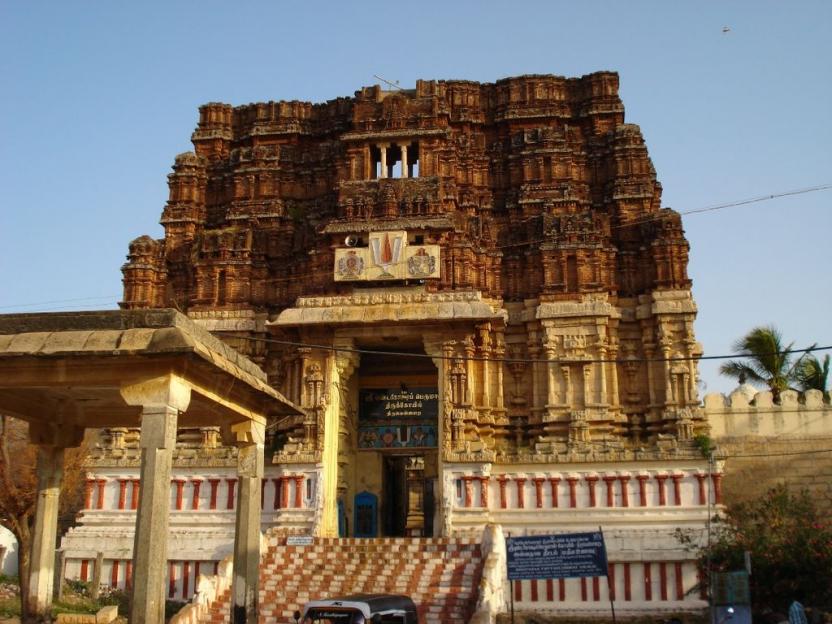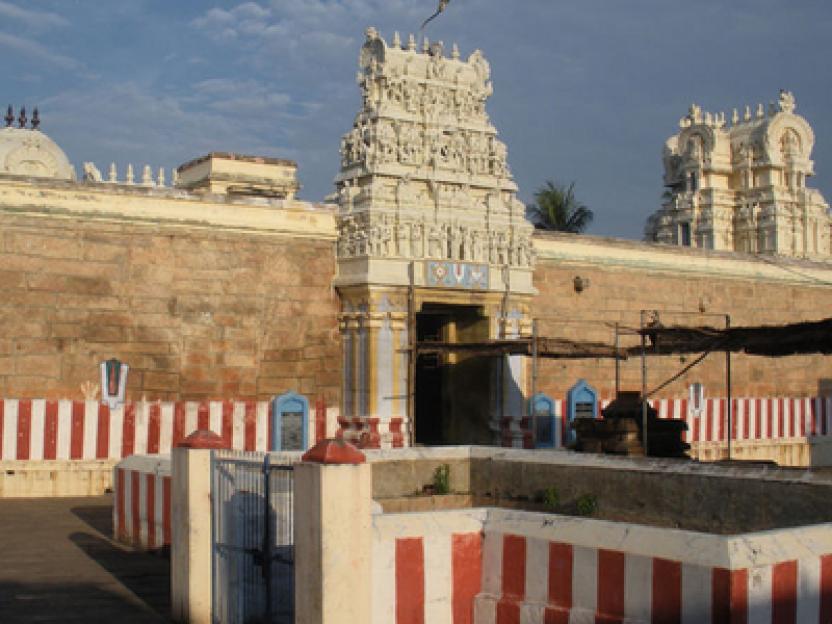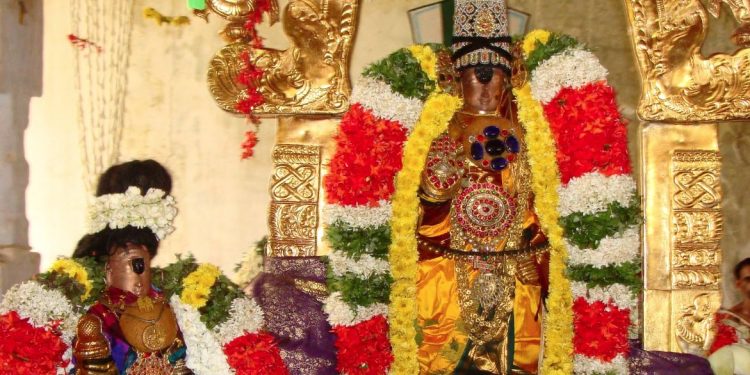Pundarikakshan Perumal is glorified in the Divya Prabandha, the early medieval Tamil canon of the Azhwar saints from the 6th?9th centuries AD. It is one of the 108 Divyadesam dedicated to Vishnu,who is worshipped as Pundarikakshan and his consort Lakshmi as Pankajavalli.
Shrine’s History
Pundarikakshan Perumal temple is believed to have been built by the Pallavas, as seen from the three inscriptions in its two rock-cut caves. Two of the inscriptions are dated from the period of Nandivarman II and the other from the period of Dantivarman . The temple construction completed presumably during the time of Dantivarman. The influence of Azhwars, the Vaishnava saints of the 7th?9th centuries helped spread Vaishnavism to a greater extent among the public and the ruling Pallava kings, who became temple patrons.
A Chola inscription indicates an endowment to the shrines of Krishna and his consort Rukmini inside the temple by King Parakesarivarman .The temple had later additions from the subsequent Chola, later Pandyas, Hoysala and the Vijayanagara kings. The temple suffered extensive damage during a flood and was repaired by a merchant around 1262?63. In modern times, the temple is maintained and administered by the Hindu Religious and Endowment Board of the Government of Tamil Nadu. An Executive officer appointed by the Board manages the temple along with Srirangam Ranganathaswamy temple, Sri Azhagiya Manavala Perumal Temple at Woraiyur, Sri Vadivazhagiya Nambi Perumal Temple and Mariamman Temple at Anbil. Annadhanam scheme, which provides free food to devotees, is implemented in the temple by the Board. Under the scheme, free food is offered to hundred devotees every day in the temple and the expenditure is fully funded by the contributions from devotees.

Legends Associated with This Shrine
The word Vellarai means white rock. Owing to the presence of white rocks in the region, the place is historically referred as Thiru Vellara. As per Hindu legend, when Sibi Chakravarthi stayed there with his warriors, a white boar crossed his path. He chased it and the boar hid inside a hole. Markandeya, a sage, was doing penance there and the king narrated the incident to him. The sage asked the king to fill the hole with milk. While doing so, Hindu god Vishnu appeared before them. The sage asked the king to bring 3700 Vaishnavites from the north and build a temple on the site for Vishnu. As requested, the king took 3700 Vaishnavites and started building the temple.
While doing so, one of the Vaishnavites was killed in transit and the king was concerned by the accident. Vishnu appeared incognito as Pundarikakshan, a Vaishnavite, and requested to be counted among the 3700. According to another legend Lakshmi, the consort of Vishnu, performed penance at the temple, and Vishnu appeared before her as Sengamalakannan. The presiding deity has since been called “Thamarai Kannan”, meaning the one who has eyes resembling lotus; his consort is called “Pankacha Valli”. The Hindu god Shiva in form of Neelivaneswarar is believed to have worshipped Pundarikakshan to absolve himself from the sin of holding Brahma’s severed head. Vishnu appeared to both Shiva and Brahma, adhering to their prayers

Architectural Relevance of This Shrine
Pundarikakshan Perumal temple is located in Thiruvellarai, a village 27 km from Tiruchirappalli, on the Thuraiyur road. The shrine of Pundarikakshan is built on a 50 ft tall artificial hill. There are two stepped entrances to the sanctum, Utharayana Vaasal and Dhakshanayana Vaasal, each open for a six-month period. From 15 January to 15 June, Utharayanya Vaasal is opened, Dhakshanaya Vaasal is for the other six-month period. Pundarikakshan, the presiding deity of the temple is named “Maayavan” during Dakshinayanam and “Thai Maatha Naayagan” during Uttarayanam. The two gates in the temple are believed to represent the continuous cycle of entering into life and getting out of it. An image of the presiding deity, Pundarikakshan, is seen in a standing posture facing east. He is believed to have appeared to Garuda, Sibi Chakravarthy, Bhoomadevi, sage Markandeya, Brahma and Shiva, all of whose images are housed inside the sanctum. The consort of Pundarikakshan, Shenbagavalli, has a separate shrine. The Utsavar of Pankajavalli is called Shenbagavalli and is housed inside the same shrine. The temple has Pallava sculptural depictions of Narasimha and Varaha, two of the ten avatars of Vishnu. Narasimha is depicted holding a demon in one panel, the other shows him tearing the demon.
The rectangular walls around the temple enclose all the eight shrines and six of the seven water bodies associated with the temple. Besides the main shrine for Pundarikakshan and Pangayavalli, the temple has shrines for Azhwars, Garuda, Ramanujar and Uyyakondar. The seven water bodies are Divya Theertham, Kanda Kshree Theertham, Theertham, Chakkara Theertham, Pushkala Theertham, Padma Theertham and Varaaha Manikarnika Theertham. The vimanam is called Vimalaakkruthi Vimaanam.
There are various sculptural depictions of Krishna on the pillars of the temple, in the most notable of which he is depicted dancing on a pot. He is seen dancing in Swastika posture with his bun like hair-do, ornaments and anklet. In another sculpture, he is seen slaying the demon Bhagasura. The Vijayanagar and Nayak kings commissioned the Krishna paintings on the exterior walls of the shrine of Pundarikakshan; they have clear Telugu language labels. Paintings with some of the popular themes from the epic Ramayana were also commissioned by the Nayak kings in the temple. The rajagopuram, the main gateway tower, is an unfinished structure. A swastika-shaped temple tank built during 800 AD is present in the south-western corner of the street around the temple. It has four stepped gateways, each having 51 steps.
The tank is believed to have been built by Kamban Araiyan during the reign of Dantivarman. In modern times, it is maintained by the Department of Archaeology of the Government of Tamil Nadu. The temple complex covers an area of 2.62 ha , while the tank covers an area of 0.1256 ha. An archaeological study in 2010 revealed that the layout of the rock-cut caves in the temple is similar to that of other rock-cut temples such as the Rockford and Pechipalai cave temple. The unfinished caves in the temple, along with the lower cave temples in Tiruchirappalli and Tiruparankunram, each have a shrine for Shiva in the east and Vishnu in the west, separated by a central bay between them.
Shrine’s Map Location and How to Go There
By Road
Trichy has well maintained National Highways connected with all major cities like Chennai, Nagaerkovil etc.
By Rail
Trichy Railway station is well connected with all railway stations in Tamilnadu and has plenty of express and passenger trains from Chennai, Madurai, and Tirunelveli etc.
By Air
Trichy City has Airport with domestic and international flights from Chennai, Bangalore, Colombo, Sharjah etc.
Shrine Timings
7 A.M to 10 P.M
Events Celebrated at This Shrine
Brahmotsavam April
Pongal January
Diwali October or November
Extra Information About this Shrine
Nearby Temple
Sri Ranganathaswamy Temple Sri Azhagiya Manavala Perumal Temple Sri Purushothaman Perumal Temple Sri Pundarikashan Perumal Temple Sri Vadivazhagiya Nambi Perumal Temple Sri Appakkudathaan Perumal Temple Sri Hara Saabha Vimocchana Perumal Temple













































